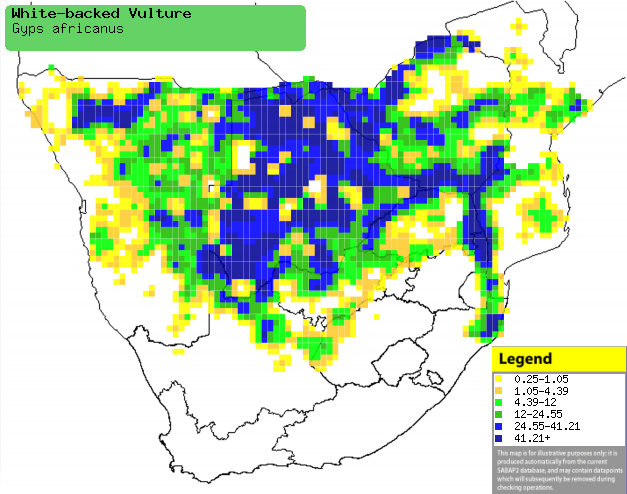|
Gyps africanus (White-backed
vulture)
Witrugaasvoël [Afrikaans]; Ekuvi (generic term for
vulture) [Kwangali]; Gora (generic name for vulture) [Shona]; Lingce
(generic term for vulture) [Swazi]; Koti (generic term for vulture)
[Tsonga]; Kopajammutla, Lenông [Tswana]; Witruggier [Dutch]; Vautour
africain [French]; Weißrückengeier [German]; Grifo-de-dorso-branco
[Portuguese]
Life
> Eukaryotes >
Opisthokonta
> Metazoa (animals) >
Bilateria >
Deuterostomia > Chordata >
Craniata > Vertebrata (vertebrates) > Gnathostomata (jawed
vertebrates) > Teleostomi (teleost fish) > Osteichthyes (bony fish) > Class:
Sarcopterygii (lobe-finned
fish) > Stegocephalia (terrestrial
vertebrates) > Tetrapoda
(four-legged vertebrates) > Reptiliomorpha > Amniota >
Reptilia (reptiles) >
Romeriida > Diapsida > Archosauromorpha > Archosauria >
Dinosauria
(dinosaurs) > Saurischia > Theropoda (bipedal predatory dinosaurs) >
Coelurosauria > Maniraptora > Aves
(birds) > Order: Falconiformes
> Family: Accipitridae
> Genus: Gyps
Distribution and habitat
Occurs in Africa south of the Sahel, avoiding the lowland
forest of the DRC. In southern Africa it is locally common
across the northern half of the region, extending into the savanna and grassland
of South Africa. It generally
prefers arid savanna with scattered trees, such as Mopane (Colosphermum mopane),
largely avoiding forests, deserts, treeless grassland and shrubland.
|
 |
|
Distribution of White-backed vulture in southern Africa,
based on statistical smoothing of the records from first SA Bird Atlas
Project (©
Animal Demography unit, University of
Cape Town; smoothing by Birgit Erni and Francesca Little). Colours range
from dark blue (most common) through to yellow (least common).
See here for the latest distribution
from the SABAP2. |
Predators and parasites
- Eggs are eaten by crows and ravens (Corvidae)
- The chicks are eaten by the following animals:
Movements and migrations
Largely resident, although juveniles and
immature birds may disperse from their parent's territories,
travelling up to about 1 500 km in search of an area to settle.
Food
It is mainly eats carrion, searching aerially until it
spots a carcass, or alternatively following mammalian carnivores and other
scavenging birds to the carcass. Once on the scene, it is extremely aggressive to
the other feeding animals, pushing them out of the way and outstretching its
neck and wings in a threat display, so that it can access the meat. It is
generally a subordinate to larger vultures, in fact in the feeding frenzy it
sometimes become stuck in the carcass and is eaten by the other scavengers! It
rarely hunts and kills its own prey, such as young Springbok (Antidorcas
marsupialis), Red-billed quelea
chicks and Warthog (Phacochoerus
aethiopicus).
Breeding
- Monogamous and usually semi-colonial, nesting either singly or in loose
colonies of up to 10 pairs, 50-200 metres apart in scattered trees.
- The nest (see images below) is a platform of sticks lined with dry grass and sometimes
green leaves, typically placed on the top of tree or on a man-made
structure, about 7-25 metres. It particularly favours the following sites:
- trees
- Acacia
- A. nigrescens (Knob thorn)
- A. galpinii (Monkey acacia)
- A. erioloba (Camel thorn)
- A. tortillis (Umbrella thorn)
- A. xanthophloea (Fever-tree acacia)
- Ficus sycomorus (Sycomore fig)
- Euclea pseudebenus (Black ebony)
- Adansonia digitata (Baobab)
- Philanoptera violacea (Apple-leaf)
- Hyphaene coriacea (Lala-palm)
- power pylon
- on top of an old nest of another bird, such as:
- Egg-laying season is from June-September in KwaZulu-Natal, and from
April-July elsewhere in southern Africa.
- It almost always lays one egg, which is incubated by both sexes for
about 56-58 days.
- At first, the chick is almost constantly brooded by both parents, who
change shifts 1-2 times per day (see images above). Both adults feed the
chick, who eventually leaves the nest at about 108-140 days old, becoming fully
independent about 5-6 months later.
Threats
Not threatened globally, but classified as Vulnerable
in South Africa, Lesotho and Swaziland. Even though it is locally common,
its population has decreased by about 10% in recent years. This is thought to
have largely been caused by poisoning, which caused at least 500 deaths in
southern Africa between 1995 and 2002.
References
-
Hockey PAR, Dean WRJ and Ryan PG 2005. Roberts
- Birds of southern Africa, VIIth ed. The Trustees of the John Voelcker
Bird Book Fund, Cape Town.
|
